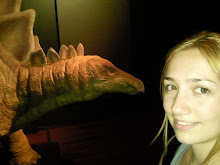 In recent news (dinosaur based):
In recent news (dinosaur based):In 2006 the youngest and most complete skeleton (including skull) of a tyrannosaur, Tarbosaurus bataar, has revealed interesting patterns of behaviour dissimilar to fully grown adults. The juvenile is definitely a Tarbosaurus bataar due to the discovery of adults of this species in Mongolia's Gobi Desert in the same site from previous expeditions. It is believed to be approximately 2 - 3 years old when the youngster died. Like a gangly teenager, this dino toddler was more agile and lithe than its parents - with the ability to out-run and out-maneuver small prey, little Tarbs could hunt for itself but without the bite force behind the infamous tyrannosaur jaws.
Little Tarbs is an important discovery on many levels: (1) the feeding behaviour of young tyrannosaurs is a first for palaeo-science, suggesting tyrannosaurs changed dietary preferences as they matured; (2) this supports the notion that tyrannosaurs were not simply scavengers, but that they had the ability to hunt for themselves; (3) lastly, this juvenile will help clarify whether juvenile and adult specimens of tyrannosaurs previously classified are of the same or different species, ie. "Jane" is she a juvenile Tyrannosaurus OR an adult Nanotyrannus? We may just be able to find out.
Tsuihiji, T., Watabe, M., Tsogtbaatar, K., Tsubamoto, T., Barsbold, R., Suzuki, S., Lee, A. H., Ridgely, R. C., Kawahara, Y., and Witmer, L. M. 2011. Cranial osteology of a juvenile specimen of Tarbosaurus bataar (Theropoda, Tyrannosauridae) from the Nemegt Formation (Upper Cretaceous) of Bugin Tsav, Mongolia. Journal of Vertebrate Paleontology, vol. 31, no. 3, pp 497 - 517
Little Tarbs is an important discovery on many levels: (1) the feeding behaviour of young tyrannosaurs is a first for palaeo-science, suggesting tyrannosaurs changed dietary preferences as they matured; (2) this supports the notion that tyrannosaurs were not simply scavengers, but that they had the ability to hunt for themselves; (3) lastly, this juvenile will help clarify whether juvenile and adult specimens of tyrannosaurs previously classified are of the same or different species, ie. "Jane" is she a juvenile Tyrannosaurus OR an adult Nanotyrannus? We may just be able to find out.
Tsuihiji, T., Watabe, M., Tsogtbaatar, K., Tsubamoto, T., Barsbold, R., Suzuki, S., Lee, A. H., Ridgely, R. C., Kawahara, Y., and Witmer, L. M. 2011. Cranial osteology of a juvenile specimen of Tarbosaurus bataar (Theropoda, Tyrannosauridae) from the Nemegt Formation (Upper Cretaceous) of Bugin Tsav, Mongolia. Journal of Vertebrate Paleontology, vol. 31, no. 3, pp 497 - 517



No comments:
Post a Comment